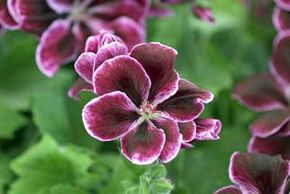Essential oils, the fragrant, concentrated liquids extracted from the flowers, leaves, roots, bark, and fruit of an aromatic plant, are the main ingredients in aromatherapy treatments. Each oil has a unique scent as well as constituents that can treat many different conditions. The essential oils profiled on this page are among the most common, commercially available oils, and they are very versatile. The profiles will tell you about each oil's therapeutic and cosmetic uses, scent, and principal constituents. You'll also find some intriguing myths and folklore associated with the oils.
Whether you’re a veteran or a beginner just getting started, these profiles will help you get more acquainted with the building blocks of aromatherapy.
Advertisement
Benzoin
Bergamot
Bergamot is used as an additive in teas, beverages and candies. This essential oil is also used for fighting viruses like the flu.
Birch
We are all familiar with the birch tree and the wildly popular birch beer. You can also use this essential oil to relieve muscle pain and stiffness.
Cedarwood
This tree can gros to over 100 feet in height, but its essential oil is used in very small amounts to treat congestion.
Advertisement
Chamomile
Chamomile is a common variety of tea, but these fragrant flowers and also used to treat depression.
Cinnamon
Cinnamon is a common kitchen ingredient that can also be used in aromatherapy to reduce drowsiness and irritability.
Clary Sage
This essential oil has been rumored to treat a variety of conditions, but is mostly commonly used to relieve muscle and nervous tension.
Clove
Cloves are another spice that can be found in many recipes. In aromatherapy, the clove can be used as an antiseptic and pain-reliever.
Cypress
The cypress tree is typically found in the Mediterranean region. Its essential oil can be used to treat low blood pressure and poor circulation.
Advertisement
Eucalyptus
The eucalyptus tree is typically found in Australia. Its essential oil can be used to treat flu, fever, and sort throat.
Fir
Fir trees are better known to most people as the typical Christmas tree. The pleasing smell of the fir tree’s essential oil can soothe muscle and rheumatism pain.
Frankincense
Geranium
Geraniums are familiar flowers that can be found in many yards throughout the country. This perennial plant can also be used to treat a variety of skin conditions and infections.
Ginger
Most of us have experienced ginger in baked goods or Asian-inspired recipes. This plant can also be used to stimulate the appetite and relieve headaches.
Advertisement
Jasmine
The beautiful jasmine flower has been used to make everything from tea to perfume. Its essential oil can also be used in aromatherapy to calm the nerves and treat depression and insomnia.
Juniper Berry
The juniper berry is standard ingredient in gin. While most people might view this as medicine, the juniper berry’s essential oil can also be massaged in the skin to treat arthritis, varicose veins, and other conditions.
Lavender
Lavender has been used for century in a number of religious and cosmetic preparations. Today, you can use this essential oil to muscle pain, migraines, and sinus infections.
Lemon
What more can be said about lemons? They’re used in all sorts of recipes from salad dressings to lemonade. The strong citrus smell of the lemon essential oil is also used to treat sore throats, coughs, and other infections.
Lemongrass
Lemon grass is a standard ingredient in traditional Southeast Asian cuisine, but it also gives Ivory Soap its familiar smell. Learn how lemon grass can be used a pain-reliever.
Advertisement
Marjoram
Marjoram has many sedative qualities, including eases stiff joints, muscle spasms, and headaches.
Myrrh
Myrrh has been used since antiquity as incense in religious ceremonies. This essential oil can also be used to treat chapped, cracked, or aging skin.
Neroli
Neroli might be an unfamiliar name, but its essential oil is used in many perfumes and beauty products. Learn how to neroli to improve circulation and skin health.
Orange
Yep, we’re talking about good-old-fashioned, vitamin-c-laden, oranges. Find out how this fruit’s essential oil can be used to alter moods and lower high blood pressure.
Patchouli
Long associated with hippies, patchouli oil has long been used as a perfume. The patchouli essential oil can also be used as a cell rejuvenator and as an antifungal treatment.
Advertisement
Peppermint
Peppermint is one of the most widely used aromatic oils in both edible and nonedible preparations. Peppermint’s essential oil is also commonly used as digestion aid.
Rose
The smell of the rose has been celebrated for centuries, and it is commonly associated with romance and special occasions. The rose’s essential oil can also be used to treat cuts burns, a number of skin problems.
Rosemary
The popular spice rosemary can also be an integral ingredient in many massage oils and body soaks.
Sandalwood
The sandalwood essential is derived from the sandalwood tree that goes through an elaborate manufacturing process. This essential oil can be used to treat infections and counter inflammation.
Tea Tree
Tea tree oil is sometimes cal a “medicine cabinet in a bottle.” Learn how this essential oil can treat bacteria, fungi, viruses, and stimulate the immune system.
Advertisement
Thyme
While thyme is usually associated with the kitchen, it also has many aromatherapy applications. Learn how this essential oil can be used to fight infections.
Ylang Ylang
The ylang ylang plant was originally cultivated in the Philippines, but it soon made its way around the world because of its distinctive scent and beautiful appearance. Learn how this plant’s essential oil is used to relax both the mind and body.
Advertisement
